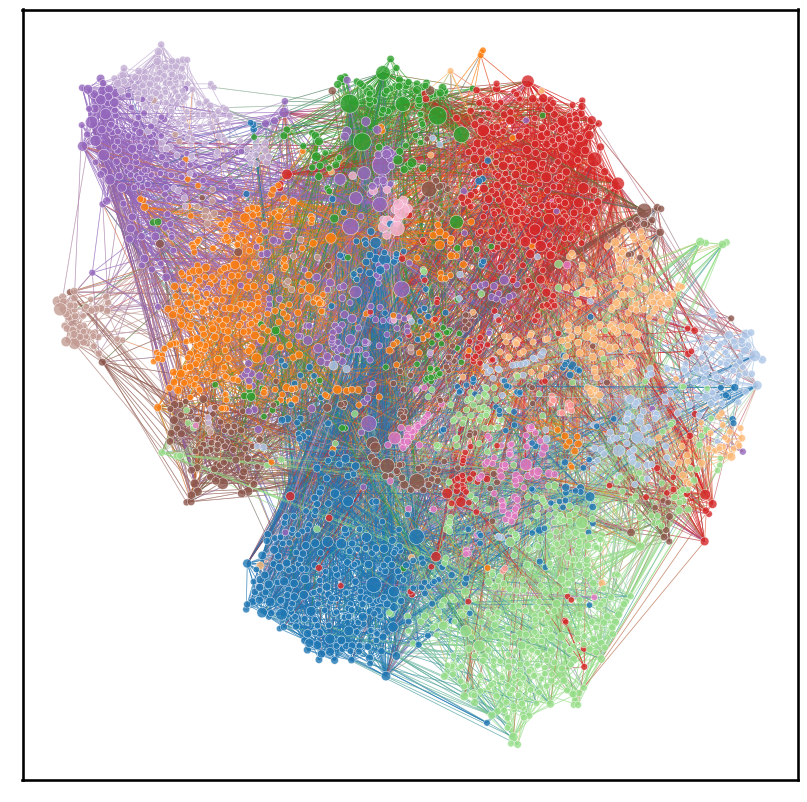Replicate Fig 1
Replicate Fig 1#
In this notebook we will be replicating figure 1 of the paper Whole-animal connectome and cell-type complement of the three-segmented Platynereis dumerilii larva, which is a network plot of the neurons in the larva’s connectome
import os
import logging
import pandas as pd
import numpy as np
import networkx as nx
from itertools import chain, combinations
from upsetplot import plot
from matplotlib import pyplot as plt
from networkx import from_numpy_array, number_of_nodes, number_of_edges, density
from graspologic.embed import AdjacencySpectralEmbed
from graspologic.layouts import layout_tsne, layout_umap
from graspologic.plot.plot import networkplot
from graspologic.utils import is_fully_connected, largest_connected_component, is_symmetric, symmetrize
from pkg.platy import load_connectome_adj, _get_folder
/Users/kareefullah/Library/Caches/pypoetry/virtualenvs/platy-data-EVeqgmAk-py3.9/lib/python3.9/site-packages/tqdm/auto.py:22: TqdmWarning: IProgress not found. Please update jupyter and ipywidgets. See https://ipywidgets.readthedocs.io/en/stable/user_install.html
from .autonotebook import tqdm as notebook_tqdm
skids side class segment type group
0 2015233 l s head 100.0 NaN
1 1548290 l NaN 1 NaN NaN
2 1318919 l s head 88.0 15.0
3 2015241 l s head 100.0 NaN
4 1646603 r NaN 3 NaN NaN
... ... ... ... ... ... ...
2696 1302513 l s head NaN NaN
2697 1630186 l NaN 2 NaN NaN
2698 1441779 r NaN head NaN NaN
2699 1671147 r m 1 165.0 NaN
2700 1048573 l i 3 NaN NaN
[2701 rows x 6 columns]
skids side class segment type group
0 2007060 lr i head NaN NaN
1 139303 lr s 1 102.0 NaN
2 2007344 l im head 166.0 NaN
3 1016172 l im 1 NaN NaN
4 1999932 r sm 1 95.0 NaN
5 1320159 rc i head NaN NaN
6 1631592 lc NaN pygidium NaN NaN
7 1418928 lc s head 132.0 NaN
8 1320798 lc s head NaN NaN
9 370978 r sm pygidium 54.0 9.0
10 84457 rc NaN head NaN NaN
11 1462145 l im 1 NaN NaN
12 307194 rc s head 135.0 NaN
13 1462664 rc NaN 2 NaN NaN
14 1594313 r sm pygidium 93.0 9.0
15 1332516 rc s head 49.0 NaN
16 1366160 rc i pygidium NaN 1.0
17 64258 lr s 1 36.0 NaN
18 1276971 l sm 2 80.0 NaN
19 81251 lc s head 43.0 NaN
20 1302189 r im head 11.0 NaN
21 1294206 lc i head NaN NaN
folder = _get_folder()
We import the adjacency matrix for the connection of connectome neurons and save its edgelist (note: we are working with a directed graph)
adj = load_connectome_adj()
g = nx.from_pandas_adjacency(adj, create_using=nx.DiGraph)
nx.write_edgelist(g, folder / "weighted_edgelist.csv")
To be able to make a network plot of the connectome neurons, we need to extract the largest connected component of the neurons, as there are a few neurons that have a degree of 0 (no incident edges), which we cannot plot
#numpy representation of original graph
adj_numpy_orig = adj.to_numpy()
#numpy largest connected component
adj_numpy_lcc, new_inds = largest_connected_component(adj_numpy_orig, return_inds=True)
#symmetrized version of numpy_lcc
adj_numpy_sym_lcc = symmetrize(adj_numpy_lcc)
#networkx representation of symmetrized lcc graph
adj_nx_sym_lcc = nx.from_numpy_array(adj_numpy_sym_lcc, create_using=nx.DiGraph)
print(adj_nx_sym_lcc)
DiGraph with 2723 nodes and 21691 edges
#use layout_tsne to get 2d representation of graph
X, node_pos = layout_tsne(adj_nx_sym_lcc, perplexity=100, n_iter=10000)
x_pos = []
y_pos = []
node_comms = []
for pos in node_pos:
#save the assigned community of the node
node_comms.append(pos[4])
x_pos.append(pos[1])
y_pos.append(pos[2])
node_comms = np.array(node_comms)
x_pos = np.array(x_pos)
y_pos = np.array(y_pos)
degrees = np.sum(adj_numpy_sym_lcc, axis=0)
/Users/kareefullah/Library/Caches/pypoetry/virtualenvs/platy-data-EVeqgmAk-py3.9/lib/python3.9/site-packages/sklearn/manifold/_t_sne.py:800: FutureWarning: The default initialization in TSNE will change from 'random' to 'pca' in 1.2.
warnings.warn(
/Users/kareefullah/Library/Caches/pypoetry/virtualenvs/platy-data-EVeqgmAk-py3.9/lib/python3.9/site-packages/sklearn/manifold/_t_sne.py:810: FutureWarning: The default learning rate in TSNE will change from 200.0 to 'auto' in 1.2.
warnings.warn(
WARNING:graspologic.layouts.auto:Directed graph converted to undirected graph for community detection
plot = networkplot(
adjacency=adj_numpy_sym_lcc,
x=x_pos,
y=y_pos,
node_hue=node_comms,
palette="tab20",
node_size=degrees,
node_sizes=(20, 200),
edge_hue="source",
edge_alpha=0.5,
edge_linewidth=0.5,
)
plt.savefig(folder / "tsne_connectome.png")
plt.show()

#use layout_umap to get 2d representation of graph
X, node_pos = layout_umap(adj_nx_sym_lcc)
x_pos = []
y_pos = []
node_comms = []
for pos in node_pos:
node_comms.append(pos[4])
x_pos.append(pos[1])
y_pos.append(pos[2])
node_comms = np.array(node_comms)
x_pos = np.array(x_pos)
y_pos = np.array(y_pos)
degrees = np.sum(adj_numpy_sym_lcc, axis=0)
WARNING:graspologic.layouts.auto:Directed graph converted to undirected graph for community detection
plot = networkplot(
adjacency=adj_numpy_sym_lcc,
x=x_pos,
y=y_pos,
node_hue=node_comms,
palette="tab20",
node_size=degrees,
node_sizes=(20, 200),
edge_hue="source",
edge_alpha=0.5,
edge_linewidth=0.5,
)
plt.savefig(folder / "umap_connectome.png")
plt.show()

We are now interested in displaying the statistics from the graph we generated to that of the statistics given in table 1 of the paper, and we wish to make sure that our numbers are approximately the same
#given the adjacency matrix and a partition of the nodes return the modularity score
def modularity_from_adjacency(sym_adj, partition, resolution=1):
if isinstance(partition, dict):
partition_labels = np.vectorize(partition.__getitem__)(
np.arange(sym_adj.shape[0])
)
else:
partition_labels = partition
partition_labels = np.array(partition_labels)
in_comm_mask = partition_labels[:, None] == partition_labels[None, :]
degrees = np.squeeze(np.asarray(sym_adj.sum(axis=0)))
degree_prod_mat = np.outer(degrees, degrees) / sym_adj.sum()
mod_mat = sym_adj - resolution * degree_prod_mat
return mod_mat[in_comm_mask].sum() / sym_adj.sum()
#get original networkx graph (not lcc)
adj_nx_orig = nx.from_numpy_array(adj_numpy_orig, create_using=nx.DiGraph)
#stats on original graph
n_nodes_orig = adj_nx_orig.number_of_nodes()
n_edges_orig = adj_nx_orig.number_of_edges()
dens_orig = density(adj_nx_orig)
#cannot calc modularity because there are isolate nodes
mod_score_orig = "N/A"
avg_degree_orig = np.average(np.count_nonzero(adj_numpy_orig, axis=0))
avg_degree_orig
4.234237536656892
#get non-symmetrized lcc networkx graph
adj_nx_lcc = nx.from_numpy_array(adj_numpy_lcc, create_using=nx.DiGraph)
#stats on lcc adj
n_nodes_lcc = adj_nx_lcc.number_of_nodes()
n_edges_lcc = adj_nx_lcc.number_of_edges()
dens_lcc = density(adj_nx_lcc)
#make symmetric when calc mod
sym_adj_lcc = symmetrize(adj_numpy_lcc)
mod_score_lcc = modularity_from_adjacency(sym_adj_lcc, node_comms)
avg_degree_lcc = np.average(np.count_nonzero(adj_numpy_lcc, axis=0))
#paper stats
n_nodes_paper = 2728
n_edges_paper = 11437
dens_paper = 0.0015
mod_score_paper = 0.62
avg_degree_paper = 4.1
stats = {"Number of nodes": [n_nodes_orig, n_nodes_lcc, n_nodes_paper], "Number of edges": [n_edges_orig, n_edges_lcc, n_edges_paper], "Graph density": [dens_orig, dens_lcc, dens_paper], "Modularity": [mod_score_orig, mod_score_lcc, mod_score_paper], "Avg. degree": [avg_degree_orig, avg_degree_lcc, avg_degree_paper]}
stats_df = pd.DataFrame.from_dict(stats, orient="index", columns=["Orig adj", "LCC adj", "Paper"])
stats_df.to_csv(folder / "fig_1_stats.csv")
stats_df
| Orig adj | LCC adj | Paper | |
|---|---|---|---|
| Number of nodes | 2728 | 2723.000000 | 2728.0000 |
| Number of edges | 11551 | 11551.000000 | 11437.0000 |
| Graph density | 0.001553 | 0.001558 | 0.0015 |
| Modularity | N/A | 0.647185 | 0.6200 |
| Avg. degree | 4.234238 | 4.242012 | 4.1000 |
Looks like the values of our statistics very closely match those of the paper!
